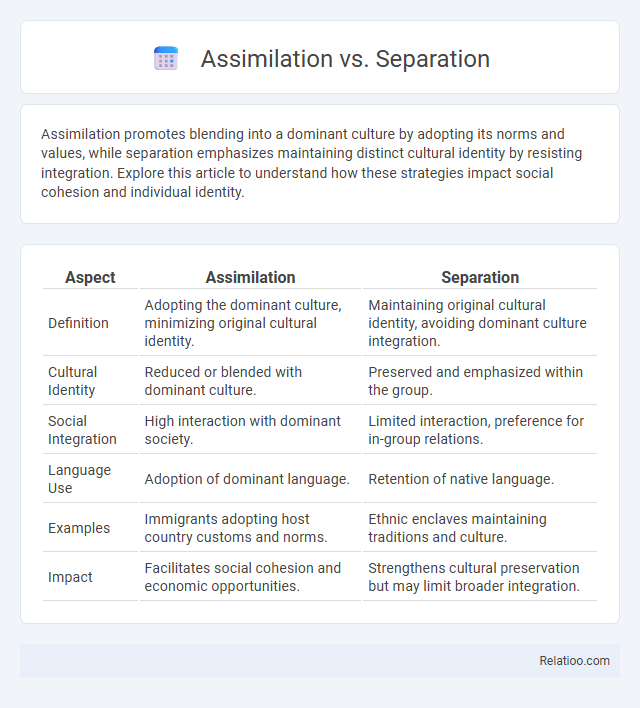Assimilation promotes blending into a dominant culture by adopting its norms and values, while separation emphasizes maintaining distinct cultural identity by resisting integration. Explore this article to understand how these strategies impact social cohesion and individual identity.
Table of Comparison
| Aspect | Assimilation | Separation |
|---|---|---|
| Definition | Adopting the dominant culture, minimizing original cultural identity. | Maintaining original cultural identity, avoiding dominant culture integration. |
| Cultural Identity | Reduced or blended with dominant culture. | Preserved and emphasized within the group. |
| Social Integration | High interaction with dominant society. | Limited interaction, preference for in-group relations. |
| Language Use | Adoption of dominant language. | Retention of native language. |
| Examples | Immigrants adopting host country customs and norms. | Ethnic enclaves maintaining traditions and culture. |
| Impact | Facilitates social cohesion and economic opportunities. | Strengthens cultural preservation but may limit broader integration. |
Understanding Assimilation and Separation
Assimilation involves adopting the cultural norms and values of a dominant group, often leading individuals to minimize their original cultural identity. Separation refers to maintaining one's original cultural traditions and avoiding interaction with the dominant culture to preserve distinct identity. Understanding these concepts helps you navigate cultural integration, recognizing the impact of either blending in or maintaining cultural boundaries on social harmony and personal identity.
Historical Context of Assimilation and Separation
Assimilation and separation reflect contrasting historical strategies in managing cultural diversity, with assimilation emphasizing the absorption of minority groups into a dominant culture, often seen during European colonial periods and nation-building efforts in the 19th and 20th centuries. Separation, by contrast, involves maintaining distinct cultural identities and social boundaries, evident in policies of apartheid in South Africa and segregation in the United States, where minority groups were deliberately isolated to preserve cultural or racial differences. The historical context of these approaches reveals underlying power dynamics and the sociopolitical goals shaping identity and integration within multicultural societies.
Key Differences Between Assimilation and Separation
Assimilation involves individuals or groups adopting the cultural traits of another, often leading to cultural blending or loss of original identity, while separation emphasizes maintaining distinct cultural identities by minimizing interaction or integration with other groups. Key differences include the degree of cultural exchange, with assimilation promoting integration into the dominant culture and separation preserving distinct cultural boundaries. Assimilation tends to foster social cohesion through shared norms, whereas separation often maintains cultural diversity by resisting cultural merging.
Cultural Identity and the Impact of Assimilation
Assimilation often leads to the erosion of cultural identity as individuals adopt the dominant culture's norms, values, and behaviors, potentially causing loss of heritage and traditions. Separation preserves cultural identity by maintaining distinct cultural practices and social boundaries, allowing minority groups to resist assimilation pressures. The impact of assimilation includes both social integration benefits and psychological challenges, such as identity conflict and reduced cultural diversity within the broader society.
Social Consequences of Separation
Separation as a social strategy often leads to diminished interaction between groups, fostering social isolation and reinforcing cultural boundaries. This division can result in reduced social cohesion, increased misunderstandings, and limited economic opportunities for the separated group. Understanding these social consequences of separation helps you navigate community dynamics and promote inclusive policies.
Factors Influencing Assimilation vs Separation
Factors influencing assimilation versus separation include cultural compatibility, perceived acceptance by the dominant group, and individual identity strength. High cultural compatibility and positive attitudes from the host society promote assimilation, while strong cultural identity and experiences of discrimination encourage separation. Socioeconomic status and language proficiency also play critical roles in determining the preferred adaptation strategy.
Assimilation and Separation in Education
Assimilation in education emphasizes integrating students from diverse cultural backgrounds into the dominant culture by encouraging uniform language, values, and behaviors, promoting social cohesion but often risking loss of cultural identity. Separation advocates for maintaining distinct cultural identities within the educational system, allowing minority groups to preserve their heritage and traditions while learning but may limit cross-cultural interaction. Balancing assimilation and separation involves creating inclusive curricula that respect cultural diversity while fostering mutual understanding and academic success.
Government Policies: Promotion or Prevention
Government policies play a crucial role in steering cultural assimilation or separation, often promoting integration by encouraging a common language, shared values, and equal participation in civic life. Preventive measures manifest through segregationist laws or policies that reinforce cultural separation, limiting access and rights for minority groups to preserve dominant cultural norms. Your understanding of these policies highlights how governments strategically influence social cohesion and cultural identity dynamics.
Case Studies: Real-World Examples
Case studies of assimilation vs separation highlight distinct cultural integration outcomes, such as immigrant communities in the U.S. adopting dominant norms versus maintaining ethnic enclaves like Chinatowns. Your understanding deepens when examining how assimilation fosters social cohesion but may erode cultural identity, while separation preserves heritage yet limits cross-group interaction. Real-world examples from countries like Canada and France reveal varying policies influencing these dynamics and their long-term societal effects.
Finding a Balance: Integration as a Middle Ground
Finding a balance between assimilation and separation requires embracing integration, which allows individuals to maintain their cultural identity while actively participating in the larger society. Integration promotes social cohesion by encouraging mutual respect and open communication between diverse groups, enhancing cultural understanding and reducing social tensions. Your ability to navigate both preserving traditions and adapting to new environments fosters a more inclusive and harmonious community.

Infographic: Assimilation vs Separation
 relatioo.com
relatioo.com